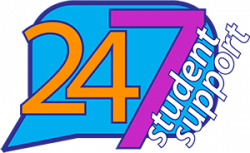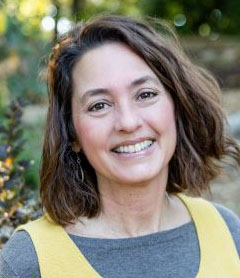
Hello! Are you looking for information about the G3 program at Virginia Western?
***
In the three years I have worked at Virginia Western, I haven’t been this enthusiastic about a grant project.
And not to get too dramatic, but I’d rank my excitement level at “Buddy the Elf.”
This is because our G3 planning grant — which I will explain more in a bit — is funding the services of the Education Design Lab, a Washington, D.C., nonprofit that helps design higher education models that improve opportunity for historically underserved learners.
How do they do this? Through design thinking, which the Lab explains in its latest white paper:
“We strongly believe in the potential of human-centered design and the principles of design thinking. They can draw institutions outside of their normal — all too often, confining — framework. Individual educators, by and large, have always put the needs of students first; if they were not mission-driven, they would select other, less stressful, better-compensated careers. But most of the institutions we work for, and the centuries-old practices of compliance and incentive, create an unwieldy, multi-layer structure that serves a lot of competing stakeholders. Students figure in there, but the tools of human-centered design pull their needs to the forefront.”
Thanks to this grant, a team from the Lab will guide Virginia Western through a design-thinking process focused on creating stackable pathways for the G3 initiative.
What is G3?
This is the initiative that was in the news around the holidays last year. G3 is a shortened version of: Get Skilled, Get a Job, Give Back; and it encourages all Virginia community colleges to create or refine stackable pathways so that skills training begins at the start of each program. What does that mean? At the bottom of this post, you will find a three-level framework provided by the VCCS. Faculty from targeted G3 programs have been invited to statewide meetings to discuss these in more detail. Ultimately, the hope is that funding will become available for a statewide last-dollar scholarship program, similar to our own CCAP program, but that’s still to be determined.
While the state identified five high-growth career sectors eligible for this program, Virginia Western chose to focus on just one — healthcare — for a few of reasons:
- Local jobs data shows the greatest industry demand and potential for growth is in healthcare, as the Roanoke region is the medical center of western Virginia. While the fastest growing occupation with higher-than-average pay in the U.S. is registered nurse, it should be noted that the recent explosion of healthcare employment has been non-clinical administrative jobs, such as receptionists and office clerks. Looking to the future, healthcare is also a good bet for continued long-term employment. Because healthcare work is so place-based and dependent on human interaction, it can weather the forces of automation and artificial intelligence.
- The aggressive grant timeline. We only have until Oct. 31 of this year to spend the grant money and complete the long list of deliverables, which I have also listed at the bottom of this post.
- Because time is short, we wanted to really take the time and focus on one sector — to dig deep and think it through. By bringing in the Education Design Lab, the college will learn the design-thinking mindset, which will help us replicate the process for additional pathways in manufacturing, IT/computer science, the trades, and early childhood education, as well as institutional challenges beyond G3. I like to think of this more as professional development than a one-time project.
What is design thinking?
I have written about design thinking before on this grants blog … about how it can help us address “wicked” problems using a methodology that truly puts students at the center of our decisions.
The project plan
For our G3 planning grant, the Education Design Lab will facilitate a series of three design workshops on our campus. We will be inviting faculty, staff, students, employers, alumni, and K-12 partners to participate at various stages in the process. In addition to helping us create or refine at least one stackable pathway in the healthcare sector, the other big design question we’ll be exploring is how we might create a more seamless, “one-door” student onboarding experience, another expected grant deliverable.
The first workshop with the Education Design Lab is planned for Tuesday, April 30, in the Natural Science Center. A broad representation of the college has been invited to the morning session, which will feature a design-thinking exercise. The core design team (listed below) will dive deeper into the challenge that afternoon and over the next six months.
If you’re curious to learn more about the Lab, I encourage you to watch this video — which shows them kicking off a similar “Seamless Transfer Pathways” project — or check out their website or recently released white paper, The Learner Revolution, which reflects on the Lab’s five years of work with 100-plus institutions.
And if you have not yet received an invite and are interested in attending one of the upcoming workshops, please raise your hand: sseagle@virginiawestern.edu.
G3 Healthcare Pathways Core Design Team:
- Kathy Beard, Dual Enrollment Coordinator
- Jeffrey Gillette, Professor, Medical Lab Technology
- Carole Graham, Dean of Health Professions
- Tracy Harmon, Associate Professor, Administrative Management Technology
- Lauren Hayward, Director of Nursing
- Marilyn Herbert-Ashton, VP of Institutional Advancement (and Project Director)
- Rachelle Koudelik-Jones, Dean of Institutional Effectiveness
- Carol Rowlett, Coordinator of Research & Assessment
- Stephanie Seagle, Grant Specialist
Grant deliverables due to VCCS by Oct. 31:
- G3 curriculum proposals and approvals
- A clearly articulated stackable pathway identifying regional employment outcomes
- Documented credential standardization activities to include course and credential results
- Agreements with regional K-12 partners for dual enrollment options
- Industry credential assessment results
- Articulated strategy for course schedule and delivery to serve targeted pathways
- Documented employer endorsements and commitments to support G3 pathways to include opportunities for work-based learning
- Community service partner agreements and draft communication plan for student advisement
- Itemized equipment list identifying needs to support program expansion
- Formal agreements to work with regional workforce agencies and investment boards
- Institutional procedures for G3 student onboarding
Stackable, Three-Level Framework
According to the VCCS, associate in applied science degree programs should, to the extent possible, adhere to the following three-level framework:
Level 1 – Core Competencies
- 16 – 20 credit hours – Career Studies Certificate
- All classes stackable to AAS
- When appropriate, FastForward course(s) may be integrated into Career Studies Certificates. To be eligible for G3, FastForward course(s) must be evaluated by qualified faculty to determine credit equivalencies, following the college’s policy on evaluating, awarding, and accepting credit for prior learning.
- Embedded industry certification(s), when appropriate
- Opportunity to complete through dual enrollment*
- Employment outcome – entry-level position in targeted industry sectors
Level 2 – Operational Skills
- 16 – 20 credit hours – Career Studies Certificate
- All classes stackable to AAS
- Embedded industry certification(s), when appropriate
- Employment outcome – technician-level position in targeted industry sector
Level 3 – Advanced Technical Proficiency
- 28 – 34 credit hours after Level 1 and 2 completion – Associate of Applied Science (60 – 66 credit hours total)
- Embedded industry certification(s), when appropriate
- Employment outcome – technologist-level position in targeted industry sector
* At least one pathway should include an option to complete Level 1 through dual enrollment.
This initiative is 100% supported by a federal U.S. Department of Labor, Employment and Training Administration Workforce Innovation and Opportunity Act (WIOA) award made to Virginia Western Community College by the pass-through entity, Virginia Community College System. The total program cost for this initiative is $176,068.






 Shelley Lyons is glad to be back on campus as she is a Virginia Western alum, and has served as the Administrative Officer for Grants Administration at Virginia Western since early 2022. Prior to VWCC, her career focus was within the Human Services and Arts fields. She wrote her first grant in 1996 on a whim and has continued to plan and learn since that time. She most enjoys seeing a well-planned project come to fruition, where funder, project manager and beneficiaries can all feel success and see impact.
Shelley Lyons is glad to be back on campus as she is a Virginia Western alum, and has served as the Administrative Officer for Grants Administration at Virginia Western since early 2022. Prior to VWCC, her career focus was within the Human Services and Arts fields. She wrote her first grant in 1996 on a whim and has continued to plan and learn since that time. She most enjoys seeing a well-planned project come to fruition, where funder, project manager and beneficiaries can all feel success and see impact.